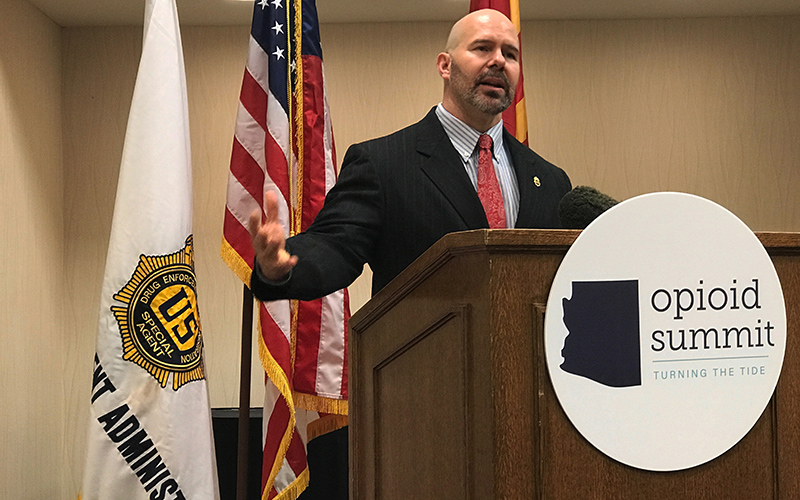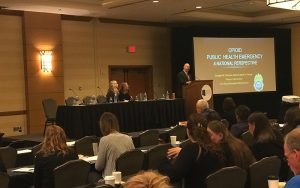
Doug Coleman, a Drug Enforcement Administration special agent in Phoenix, praised Arizona’s efforts to combat opioid abuse but predicted the crisis will get worse before it improves. (Photo by Fortesa/Latifi/Cronkite News)
TEMPE – The opioid crisis in Arizona is likely to grow, a DEA agent warned Wednesday, praising the state’s efforts so far and saying it’s time to stop playing the blame game.
“For right now, unfortunately, it looks like the problem is getting worse before it gets better,” said Doug Coleman, a special agent for the Drug Enforcement Administration in Phoenix.
Coleman framed the war on opioids as a series of front-line battles that have not yet reached peak casualties.
He was among the law-enforcement and health-care officials who met at the second annual Arizona Opioid Summit to discuss solutions to an epidemic that has led to nearly 900 deaths and 5,810 drug-related overdoses in the state since mid-June, according to state health officials.
Last month, Gov. Doug Ducey signed the Opioid Epidemic Act into law. The measure provides $10 million in treatment for underinsured or uninsured patients, restricts the number of opioids that can be prescribed at one time and protects people from drug-related prosecution if they call for emergency help during a drug overdose.
In his presentation, Coleman praised the new law, saying Arizona is “forward thinking” and “a leader” in the national opioid crisis, which claims an estimated 115 lives every day, according to the National Centers for Disease Control and Prevention.

Doug Coleman, a DEA special agent, said everyone wants someone to blame for the opioid crisis — whether doctors or the drug industry — but that’s a waste of time and effort. He spoke Wednesday to law-enforcement and health-care workers at the second annual Arizona Opioid Summit in Tempe. (Photo by Fortesa Latifi/Cronkite News)
But the connections that led to the epidemic are intertwined and deep, he said, meaning there’s no magic medicine to cure the crisis.
Everyone is trying to figure out who to blame, he said, adding that the true answer is everyone is to blame: Doctors, pharmacists, patients.
“We have to get past the idea of who’s to blame because there’s not one entity that’s to blame,” he said. “We all, as citizens of the United States, demanded these products to ease our pain, and that’s what led to this.”
First, he said, patients demanded opioids to combat their pain. Then, doctors started prescribing more painkillers. In turn, pharmaceutical companies manufactured more drugs. They provided the building blocks for a tragedy.
“We have to stop blaming each other,” Coleman said. “We have to figure out a solution.”
Janice Morrison agrees. Her son, Brett, battled heroin addiction after he was prescribed opioids following a snowboarding accident. She shares Coleman’s concern that the Arizona opioid crisis hasn’t hit its peak.
“Because of shame and stigma and fear of prosecution, people don’t reach out for help,” Morrison said. “It’s just a big mess.”
Morrison thinks law enforcement and government officials need to work with people who have experienced addiction in order to reach solutions.
Most of the conference at the Tempe Mission Palms Hotel centered on sessions to discuss law-enforcement work, pain management and treatment options.
In other ways, it was similar to other industry conferences, with a lobby of vendors offering free pens, candy and other giveaways. A rehab center marketed treatment options, such as $11,000 for a six-week outpatient program and $65,000 for a six-week inpatient program.